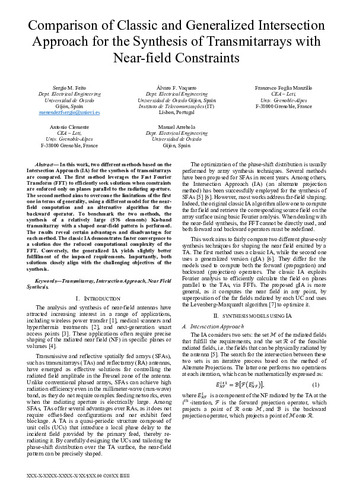Comparison of Classic and Generalized Intersection Approach for the Synthesis of Transmitarrays with Near-field Constraints
Palabra(s) clave:
Transmitarray, Intersection Approach, Near Field Synthesis
Fecha de publicación:
Resumen:
In this work, two different methods based on the Intersection Approach (IA) for the synthesis of transmitarrays are compared. The first method leverages the Fast Fourier Transform (FFT) to efficiently seek solutions when constraints are enforced only on planes parallel to the radiating aperture. The second method aims to overcome the limitations of the first one in terms of generality, using a different model for the near-field computation and an alternative algorithm for the backward operator. To benchmark the two methods, the synthesis of a relatively large (576 elements) Ka-band transmitarray with a shaped near-field pattern is performed. The results reveal certain advantages and disadvantages for each method. The classic IA demonstrates faster convergence to a solution due the reduced computational complexity of the FFT. Conversely, the generalized IA yields slightly better fulfillment of the imposed requirements. Importantly, both solutions closely align with the challenging objectives of the synthesis.
In this work, two different methods based on the Intersection Approach (IA) for the synthesis of transmitarrays are compared. The first method leverages the Fast Fourier Transform (FFT) to efficiently seek solutions when constraints are enforced only on planes parallel to the radiating aperture. The second method aims to overcome the limitations of the first one in terms of generality, using a different model for the near-field computation and an alternative algorithm for the backward operator. To benchmark the two methods, the synthesis of a relatively large (576 elements) Ka-band transmitarray with a shaped near-field pattern is performed. The results reveal certain advantages and disadvantages for each method. The classic IA demonstrates faster convergence to a solution due the reduced computational complexity of the FFT. Conversely, the generalized IA yields slightly better fulfillment of the imposed requirements. Importantly, both solutions closely align with the challenging objectives of the synthesis.
Descripción:
International Conference on Electromagnetics in Advanced Applications (ICEAA) (2023. Venice, Italy)
Patrocinado por:
This work has been supported in part by MCIN/AEI/10.13039/501100011033 within the projects PID2020-114172RB-C21 and TED2021-130650B-C22, the Spanish Ministry of Universities and European Union (NextGenerationEU fund) under project MU-21-UP2021-03071895621J, and by the Gobierno del Principado de Asturias under project AYUD/2021/51706.
Colecciones
Ficheros en el ítem





